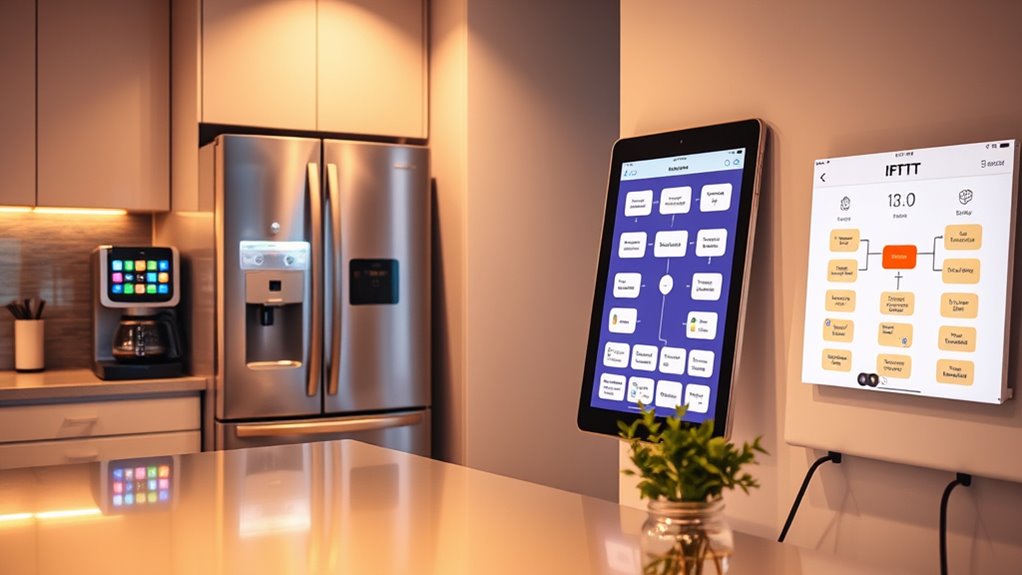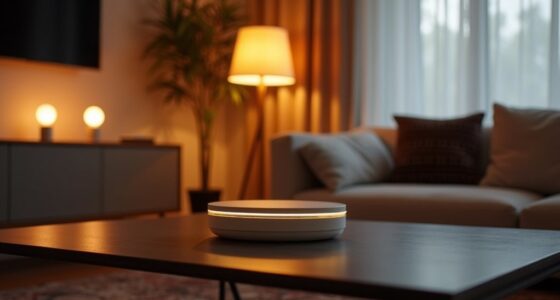To make your kitchen smarter with IFTTT, automate routines like brewing coffee as soon as your alarm sounds, adjust lighting based on the time of day or sunlight, and turn on ventilation when you start cooking. You can set reminders for groceries, control smart devices with voice commands, and schedule appliances to run at specific times. These tips help boost efficiency and comfort—keep exploring to discover even more ways to optimize your kitchen.
Key Takeaways
- Automate morning coffee brewing with IFTTT and smart plugs for a seamless wake-up routine.
- Use lighting and smart blinds to adjust brightness and temperature based on time or sunlight levels.
- Detect smoke or humidity with sensors to trigger ventilation and maintain air quality automatically.
- Set up alerts for cleaning or low inventory to keep the kitchen organized and prevent waste.
- Integrate voice commands with smart speakers for hands-free control of appliances and step-by-step recipes.
Automate Coffee Brewing With Wake-Up Routines
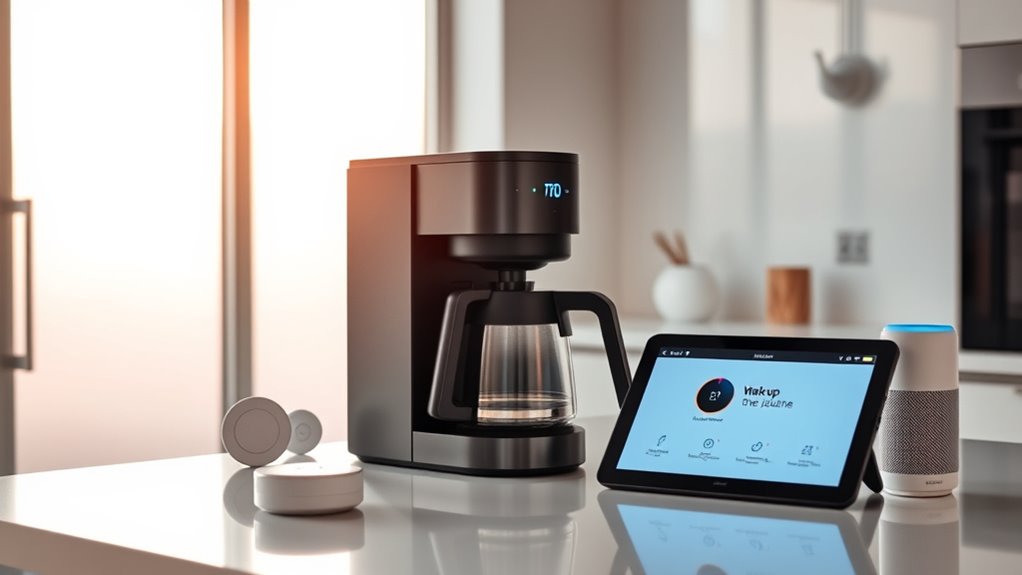
Imagine waking up to the smell of freshly brewed coffee without lifting a finger. With coffee automation, you can set up your wake-up routines to start your day perfectly. Using IFTTT, connect your smart devices to trigger your coffee maker as soon as your alarm goes off. For instance, when your smart alarm rings, it can activate a smart plug that powers your coffee machine. This seamless integration means you wake up to the aroma of coffee, making mornings smoother and more enjoyable. No more rushing to brew or waiting for it to finish. By automating your coffee prep with simple routines, you create a personalized wake-up experience that energizes you right from the moment you get out of bed.
Adjust Kitchen Lighting Based on Time of Day

Adjusting your kitchen lighting throughout the day can enhance both functionality and ambiance. With IFTTT, you can automate changes in ambient lighting to match the time of day, creating a comfortable environment. For example:
Automate your kitchen lighting to match the time of day for optimal comfort and ambiance.
- In the morning, set your lights to a cooler color temperature to energize your space.
- During midday, increase brightness for better visibility while cooking or cleaning.
- In the evening, shift to warmer tones to promote relaxation.
- At night, dim the lights for a cozy atmosphere without disturbing your sleep cycle.
- Incorporating mindful decluttering can further improve your kitchen’s organization and overall atmosphere.
Turn On Ventilation When Cooking Starts
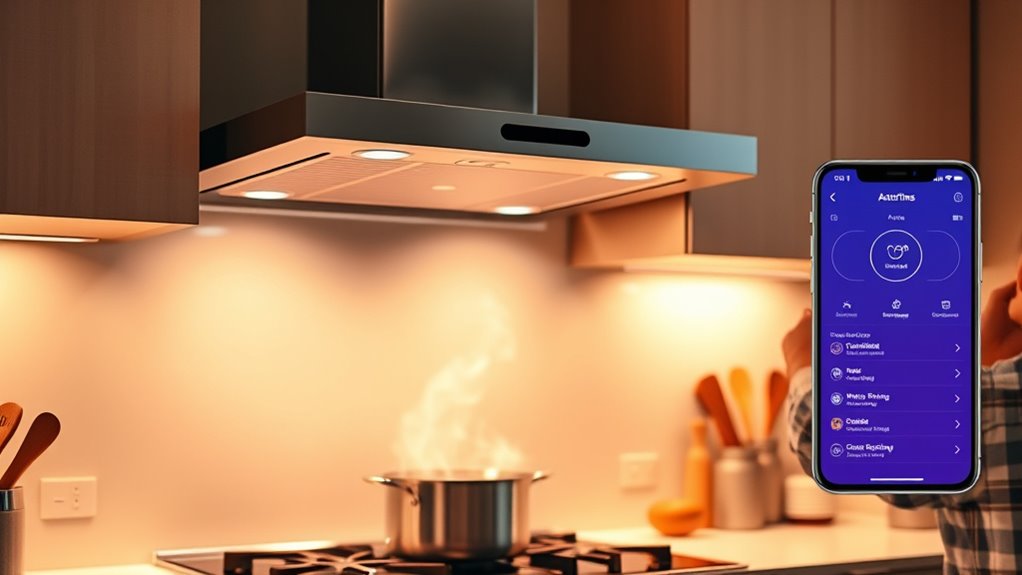
When you start cooking, automatically turning on your kitchen ventilation can substantially improve air quality and comfort. Using ventilation sensors, your smart system detects smoke, heat, or increased humidity, triggering your ventilation to activate instantly. This helps remove cooking fumes, odors, and excess moisture, keeping the air fresh and healthy. With an IFTTT setup, you can guarantee the ventilation turns on as soon as sensors detect a change in air quality, preventing buildup of harmful particles. Proper sensor placement is essential for accurate detection and effective operation of the system. This automation reduces the need for manual intervention, making your kitchen safer and more comfortable. Plus, it conserves energy by only running when necessary. Overall, integrating ventilation sensors with your smart home helps maintain ideal air quality effortlessly whenever you cook.
Send Grocery Reminders When Supplies Are Low
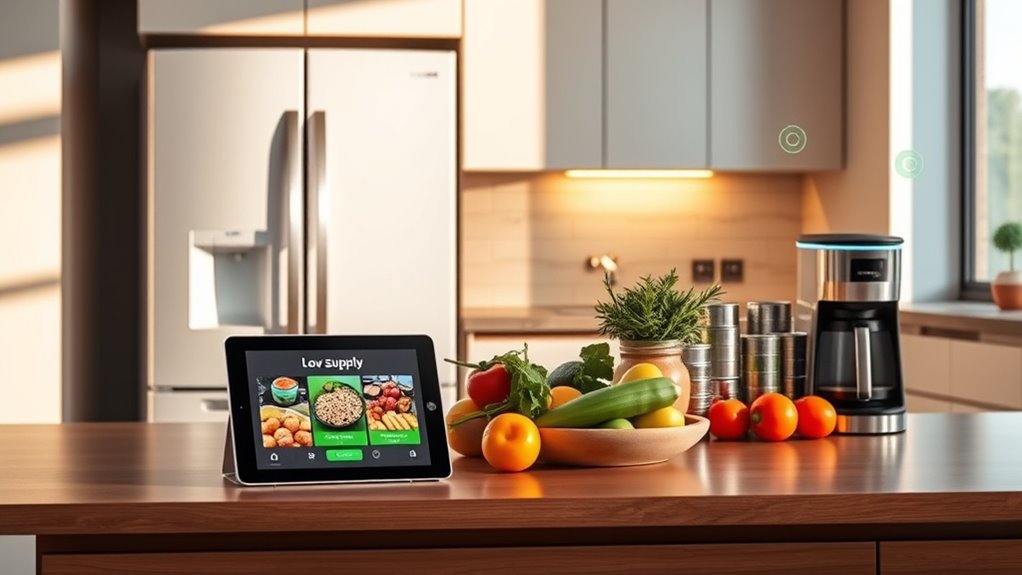
Keeping your kitchen air fresh and clean is easier when your smart home takes proactive steps, like turning on ventilation sensors during cooking. Similarly, managing your grocery inventory becomes effortless with IFTTT. When supplies run low, you can set up reminders to update your shopping list automatically. This way, you won’t forget essential items. To make it work:
- Monitor your grocery inventory with smart sensors or manual input.
- Trigger an alert when supplies fall below a predefined level.
- Automatically add the item to your digital shopping list.
- Send you a reminder to pick up the essentials before they run out.
- Remember that spoiled lemon juice can cause confusion when trying to determine freshness, so keeping an accurate inventory helps avoid unnecessary waste.
These steps help you stay organized, ensure you always have what you need, and avoid last-minute runs to the store. It’s a simple way to keep your kitchen running smoothly.
Sync Smart Speakers for Cooking Instructions
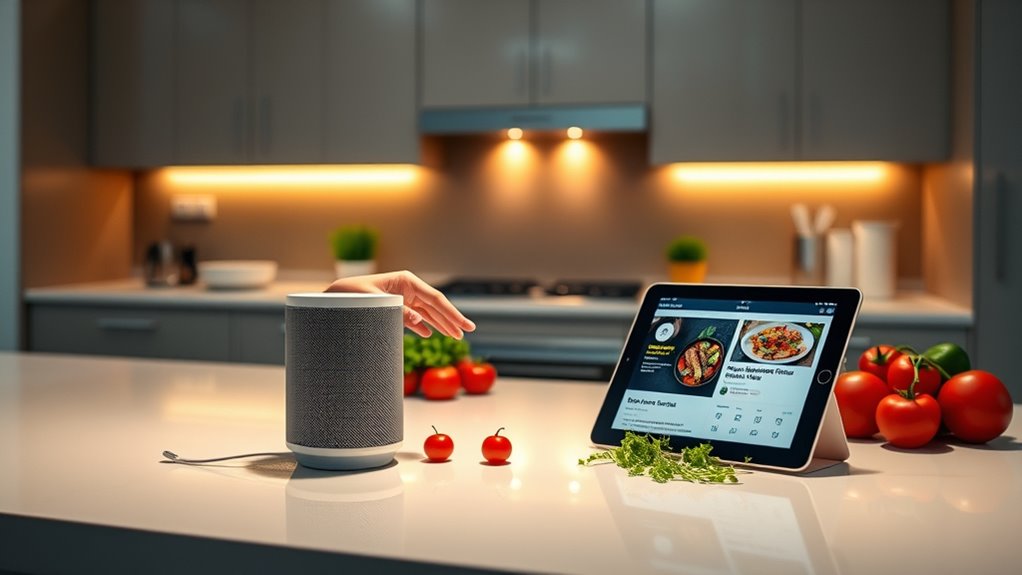
If you want to streamline your cooking process, syncing your smart speakers with recipe apps or timers can make a big difference. With voice recognition technology, you can ask your speaker to read out step-by-step instructions, keeping your hands free. This allows you to focus on your prep without constantly checking your phone. To guarantee clear communication, prioritize sound quality, so instructions are easily understood even in a noisy kitchen environment. You can set up IFTTT applets to trigger specific recipes or timers, and your smart speaker will deliver updates seamlessly. This setup reduces interruptions and helps keep your cooking smooth and organized. Additionally, optimizing your sound quality ensures that voice commands and instructions are heard clearly, even amid kitchen noise. By syncing your smart speakers, you create a more efficient and hands-free cooking experience that’s perfect for busy kitchens.
Monitor Refrigerator Temperature and Receive Alerts
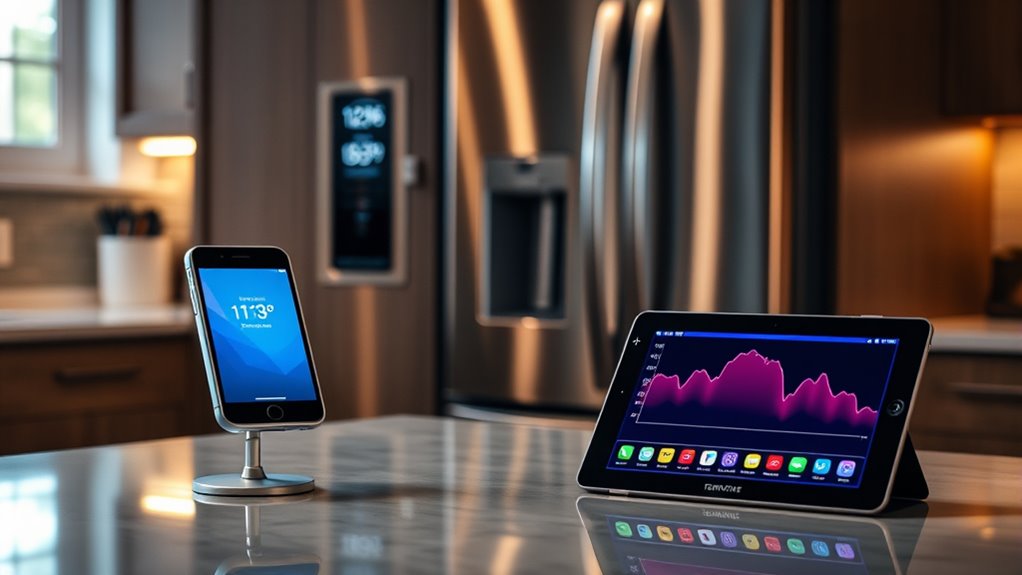
Have you ever worried about your refrigerator’s temperature drifting out of range and risking spoiled food? With refrigerator sensors and temperature monitoring, you can stay ahead of issues. Here’s how:
- Install compatible sensors inside your fridge to track real-time temperature data.
- Use IFTTT to connect these sensors to your smartphone or email alerts.
- Set custom thresholds for safe temperature ranges—say, below 40°F.
- Receive instant notifications if temperatures rise or fall unexpectedly.
- Regularly check sensor functionality to ensure accurate readings and reliable alerts for optimal performance.
Schedule Smart Plugs to Power Appliances at Specific Times
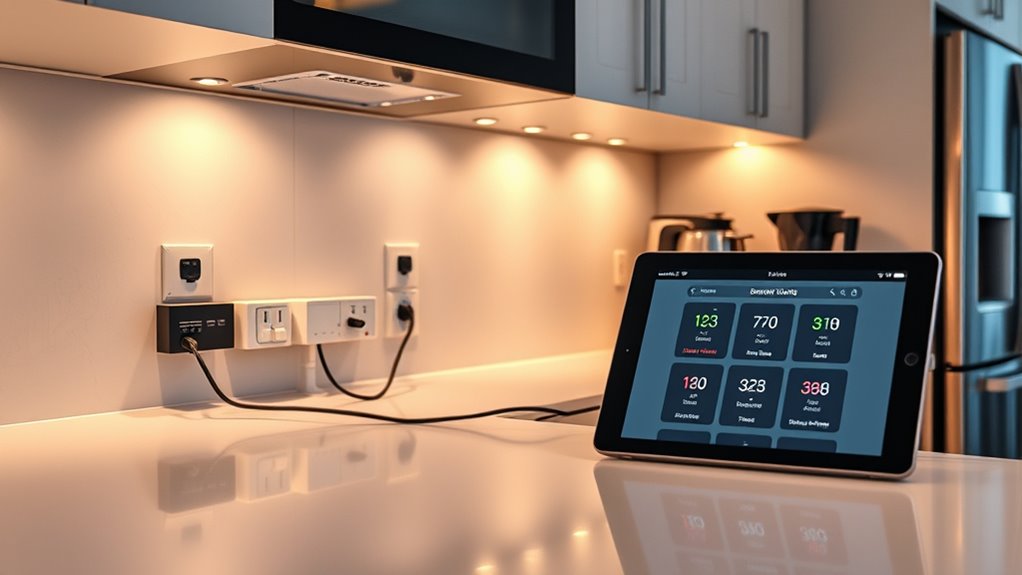
Scheduling your smart plugs to turn appliances on and off at specific times can streamline your kitchen routine and save energy. With smart plug scheduling, you can automate coffee makers, microwaves, or slow cookers to operate exactly when needed. This appliance automation guarantees appliances aren’t left running unnecessarily, reducing energy waste and lowering bills. For example, you can set your coffee maker to start brewing before you wake up or schedule your slow cooker to turn off after dinner. Using IFTTT, you can create routines that activate appliances based on time, enhancing convenience and efficiency. Incorporating energy-efficient practices like scheduled appliance use not only simplifies daily tasks but also minimizes manual effort and helps you maintain a smarter, more energy-conscious kitchen.
Create a Cleaning Reminder When Kitchen Is Used
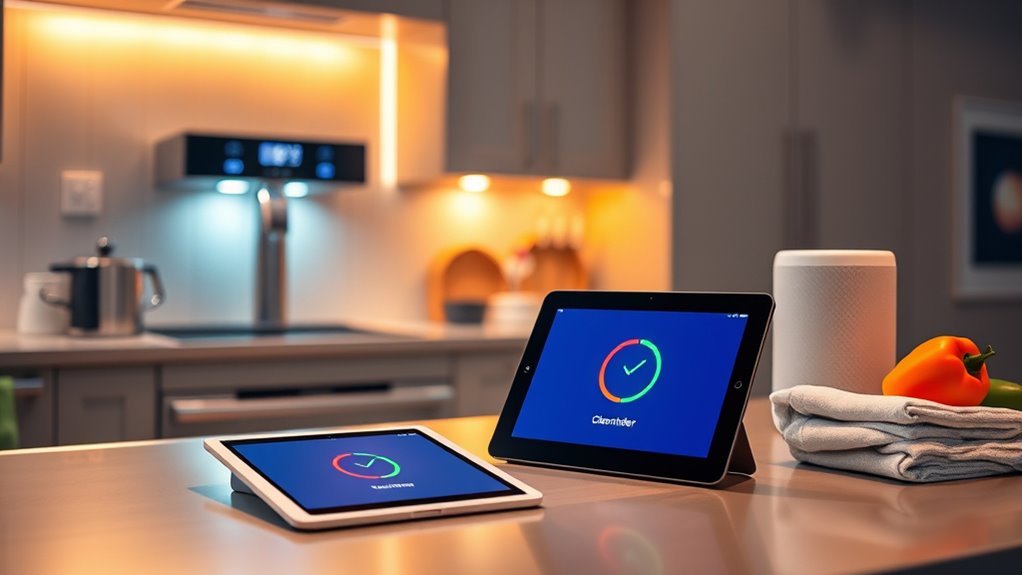
Whenever you use your kitchen, you can set up an IFTTT applet to detect activity and send you a cleaning reminder. This automation helps keep your space tidy without extra effort on your part. With just a few taps, you’ll stay on top of cleanup after every meal. Incorporating automation technology can further optimize your kitchen routines for efficiency.
Detect Kitchen Activity
By setting up IFTTT to detect activity in your kitchen, you can automatically create a cleaning reminder whenever the space is used. Start with proper sensor calibration to guarantee accurate user activity detection, so your system responds reliably. Next, connect your motion sensors or smart appliances to trigger IFTTT when activity is detected. Here’s how to optimize this setup:
- Calibrate sensors regularly for precise detection.
- Use motion sensors or smart switches to identify user presence.
- Set triggers for specific activity levels or times.
- Test the system to avoid false positives or missed activity.
Regularly reviewing your setup can help maintain remote work productivity by ensuring your environment stays clean and organized with minimal effort.
With these steps, your kitchen becomes smarter, prompting cleaning reminders only when needed, saving time, and maintaining cleanliness effortlessly.
Automate Cleaning Alerts
Once your kitchen activity is detected, you can set up IFTTT to automatically send you a cleaning reminder. This guarantees you stay on top of refrigerator maintenance and pantry organization without extra effort. For example, after cooking or using the sink, IFTTT can trigger a reminder to wipe surfaces or check expiration dates. You could also schedule alerts to tidy up the pantry, preventing clutter from building up. By automating these cleaning alerts, you keep your kitchen hygienic and organized effortlessly. This proactive approach helps extend appliance lifespan and keeps everything running smoothly. Integrating sensors or smart devices with IFTTT makes it easy to maintain a clean, efficient kitchen that stays in top shape with minimal manual effort.
Control Smart Blinds Based on Sunlight Levels
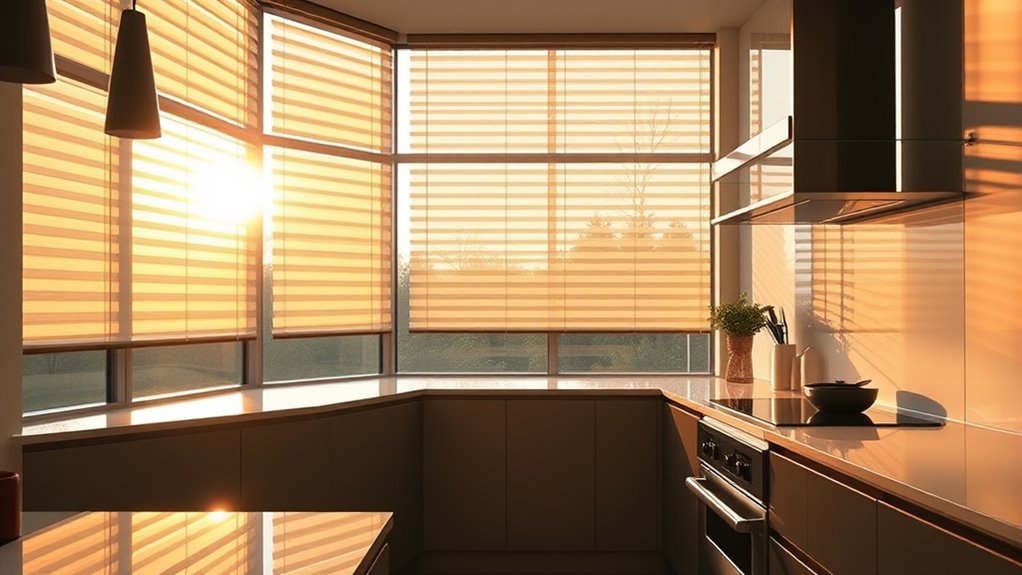
You can use sunlight detection methods like light sensors or weather data to trigger your smart blinds. Automating the adjustment helps keep your kitchen comfortable and energy-efficient. Let’s explore how to set this up for seamless sunlight-based control. Implementing these techniques aligns with ethical hacking principles, ensuring your automation remains secure from potential vulnerabilities.
Sunlight Detection Methods
Smart blinds can automatically adjust based on sunlight levels, ensuring your kitchen stays comfortable and energy-efficient. To do this effectively, you need reliable sunlight detection methods. First, calibrate your light sensor regularly to maintain accuracy. Second, analyze sunlight patterns throughout the day to understand peak brightness times. Third, choose sensors with high sensitivity and quick response times for better performance. Fourth, consider integrating sunlight pattern analysis with your IFTTT setup to fine-tune blind adjustments. Accurate light sensor calibration helps prevent false readings, while sunlight pattern analysis enables smarter automation. Additionally, understanding sunlight patterns can help optimize the timing of blind adjustments for maximum energy savings. Together, these methods ensure your smart blinds respond precisely to changing sunlight,
Automating Blinds Adjustment
Automating blinds adjustment based on sunlight levels allows your smart home to respond dynamically, enhancing comfort and energy efficiency. By integrating smart blind sensors, you can set up IFTTT applets for seamless sunlight adjustment throughout the day. When sunlight increases, your smart blinds automatically lower to reduce glare and heat gain. Conversely, on cloudy days or when sunlight diminishes, the blinds rise to maximize natural light. This system ensures your space stays comfortable without manual intervention. You can customize thresholds based on time or sunlight intensity, optimizing energy use and preserving privacy. With real-time data from smart blind sensors, your blinds adapt instantly, creating a smarter, more responsive environment that adjusts effortlessly to changing sunlight conditions.
Set Up Voice Commands to Manage Kitchen Devices
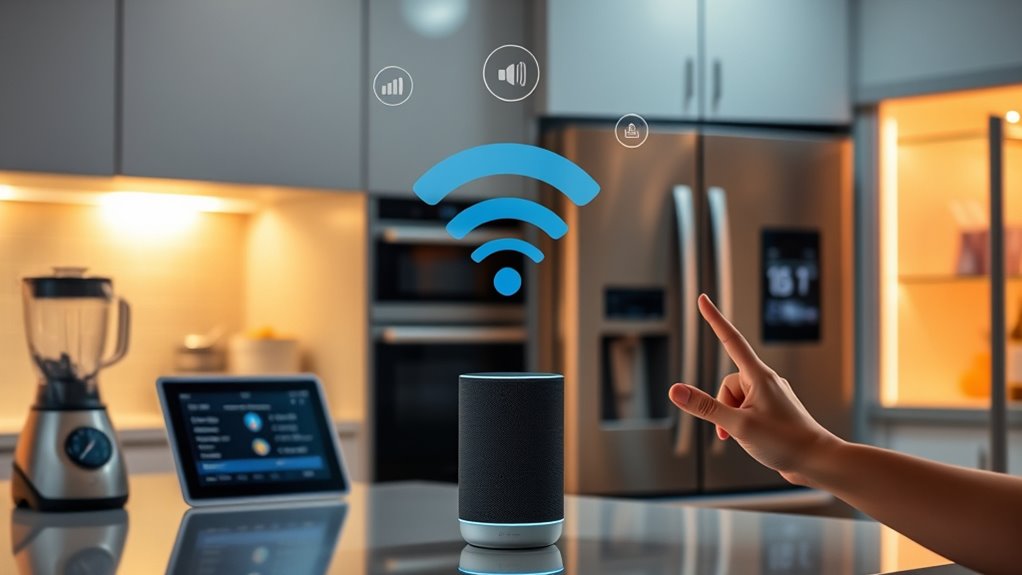
Setting up voice commands to control kitchen devices transforms your cooking space into a hands-free haven. With voice control, you can effortlessly manage appliances and enhance kitchen automation. To get started:
- Choose a compatible voice assistant like Alexa or Google Assistant.
- Connect your smart kitchen devices to your preferred automation platform.
- Create custom voice commands through IFTTT to trigger device actions.
- Test your setup by giving voice commands such as “Start the coffee maker” or “Turn on the oven lights.”
This setup streamlines your routine, keeps your hands free, and makes kitchen management more efficient. Voice control simplifies complex routines and integrates seamlessly with your smart home system. Now, your kitchen responds instantly to your commands, making cooking more enjoyable.
Frequently Asked Questions
Can I Integrate IFTTT With Non-Smart Kitchen Devices?
You can indeed integrate non-smart appliances with IFTTT through manual methods. While these devices don’t have built-in smart features, you can connect them using smart plugs, sensors, or other automation tools that communicate with IFTTT. By setting up manual integration, such as using a smart outlet or a sensor trigger, you enable your non-smart appliances to respond to automated commands, making your kitchen smarter without replacing your existing devices.
How Secure Are IFTTT Automations in My Kitchen?
Is your kitchen a fortress or a fragile castle? When you use IFTTT automations, you’re trusting your devices’ security protocols. While these platforms implement encryption and regular updates, privacy concerns still exist if your account isn’t well protected. Stay vigilant, use strong passwords, and enable two-factor authentication to minimize risks. Remember, automation can simplify your life, but safeguarding your privacy keeps your kitchen safe and sound.
Can I Customize Notifications for Specific Kitchen Activities?
You can definitely customize notifications for specific kitchen activities. By setting up activity alerts, you receive custom notifications whenever certain events happen, like a door opening or the fridge door being left open. This way, you’re always informed about what’s happening in your kitchen. Adjust your IFTTT applets to trigger personalized alerts, giving you control and peace of mind with real-time updates tailored to your needs.
Is It Possible to Create Multiple User Profiles for Kitchen Automation?
You can set up multiple user profiles for your kitchen automation, enabling multi-user access. This way, each person can customize their preferences, notifications, and device controls. Many smart home platforms support creating distinct profiles, making it easy to personalize the experience and guarantee everyone has the right level of access. By configuring user profiles, you improve convenience and security, allowing your smart kitchen to cater to everyone’s needs seamlessly.
What Are the Best Practices for Troubleshooting IFTTT Kitchen Setups?
When troubleshooting your IFTTT kitchen setups, start by checking for automation errors, which often cause issues. Verify all devices are compatible with IFTTT and updated to the latest firmware. Test each applet individually to pinpoint problems, and review your account connections for any disruptions. If issues persist, consult IFTTT’s support resources or community forums for specific device compatibility tips and troubleshooting advice.
Conclusion
With these IFTTT hacks, you can transform your kitchen into a smarter, more efficient space. Did you know that 70% of homeowners who automate their homes report increased convenience and energy savings? By customizing routines like brewing coffee or adjusting lighting, you’ll save time and reduce waste. Start integrating these simple tricks today, and enjoy a kitchen that works seamlessly around your lifestyle—making every meal prep and cleaning session easier and more enjoyable.
